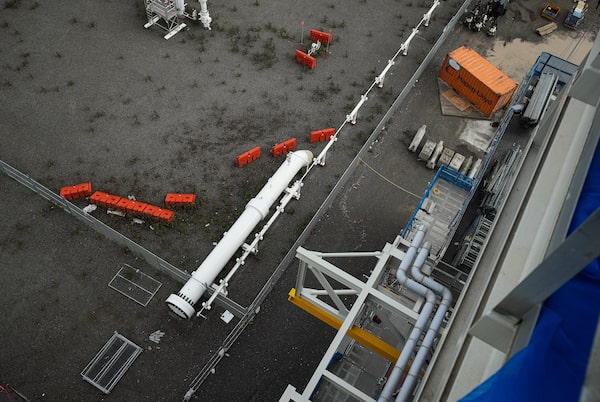
The terminus for the Coastal GasLink natural gas pipeline is seen at the LNG Canada export terminal under construction in Kitimat, B.C., on Sept. 28, 2022.DARRYL DYCK/The Canadian Press
Natural gas producers in Canada will likely find it increasingly attractive to send the fuel through pipelines to the United States instead of relying on plans to export overseas, a new study has found.
Costs are significantly higher in Canada than in the U.S. for constructing terminals for exporting liquefied natural gas and building the associated pipelines, said Clark Williams-Derry, a Seattle-based analyst with the Institute for Energy Economics and Financial Analysis (IEEFA).
That applies to the $11.2-billion Coastal GasLink pipeline in northern British Columbia and the proposed routing for the Woodfibre LNG project near Vancouver. Both are at a major cost disadvantage to projects on the U.S. Gulf Coast, where there is already a pipeline network to supply natural gas for LNG plants, he said.
“Infrastructure costs are really becoming a financial issue as a headwind for LNG in B.C.,” Mr. Williams-Derry said in an interview.
TC Energy Corp. TRP-T, the operator of Coastal GasLink, plans to announce an increase in the construction cost estimates for the B.C. pipeline in mid-February.
The Coastal GasLink project, which would feed the $18-billion LNG Canada export terminal under construction in Kitimat, B.C., is forecast in the IEEFA study to have pipeline tolls for transporting across the province that could be almost double what it would cost producers to pipe natural gas to the Gulf Coast.
Last year, Enbridge Inc. ENB-T announced its purchase of a 30-per-cent stake in Woodfibre, while Pacific Energy Corp. Ltd. owns the remaining 70-per-cent interest. Woodfibre’s construction costs are forecast to total US$5.1-billion, including the Squamish-area export terminal and other expenses, notably those related to FortisBC’s proposed Eagle Mountain-Woodfibre Gas Pipeline.
The co-owners of LNG Canada are considering a major expansion in Kitimat in what would be Phase 2, with the option to utilize gas-fired turbines initially for liquefaction and then subsequently switching over to electric power.
Aside from Woodfibre and LNG Canada, three other projects for exports using tankers remain active in B.C.: Cedar LNG, Ksi Lisims LNG and Tilbury LNG’s expansion plans.
Mr. Williams-Derry said LNG Canada enjoys some advantages such as having frequently cold temperatures in Kitimat, making it more energy efficient in northern B.C. to supercool natural gas into liquid form, compared with the warmer climate at LNG export terminals on the Gulf Coast. As well, LNG Canada has access to relatively affordable feedstock of natural gas in northeast B.C., and the LNG joint venture could be favourably positioned if LNG prices in Asia remain at elevated levels when the Kitimat terminal begins exports in 2025, he said.
The terminal, pipeline and drilling are forecast to cost $45-billion. London-based Shell PLC, Malaysia-based Petronas, PetroChina, Japan’s Mitsubishi Corp. and South Korea’s Kogas are the co-owners of LNG Canada.
ARC Resources Ltd. and Tourmaline Oil Corp., both based in Calgary, have already signed contracts to sell natural gas for the Gulf Coast market.
As North American and global markets evolve, more Canadian independent producers could see the Gulf Coast as an attractive option, Mr. Williams-Derry said.